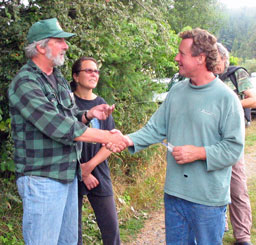Old growth protected on former Pacific Lumber lands
Tree sitters descend when new owners Humboldt Redwood Co. deliver message directly to them
 News release from BACH:
News release from BACH:
Bay Area Coalition for Headwaters
August 19, 2008
Eureka, CA – Community residents and forest activists from the redwood region and far beyond Humboldt County in Northern California, were relieved and elated as news spread of an unprecented commitment by Humboldt Redwood Company (HRC) owners of what was Maxxam/PL land to spare the Nanning Creek and Fern Gully ancient groves where tree-sits have been keeping chain saws at bay. The message was delivered directly to tree-sitters and included a commitment to further protect from future cutting all old growth 250 years old or more.
 “Old Growth now included in old PL timber harvest plans will be taken out of those plans,” said HRC president and chief forester, Mike Jani, in an interview with KMUD radio in Garberville last week. This in itself is a significant change from company CEO Sandy Dean’s position of just two months ago, when he stated, on KMUD and in the San Francisco Chronicle on Aug. 29, that HRC would be finishing up the former owners’ harvest plans and that it would “take time” to switch over to the new forestry methods.
“Old Growth now included in old PL timber harvest plans will be taken out of those plans,” said HRC president and chief forester, Mike Jani, in an interview with KMUD radio in Garberville last week. This in itself is a significant change from company CEO Sandy Dean’s position of just two months ago, when he stated, on KMUD and in the San Francisco Chronicle on Aug. 29, that HRC would be finishing up the former owners’ harvest plans and that it would “take time” to switch over to the new forestry methods.
Equally stunning was the manner chosen by forester Jani to convey the message, delivering it directly to the forest defender tree sitters themselves. He hiked in to Nanning Creek and the Fern Gully treesit in Freshwater, near Eureka. Activists have been treesitting in these areas to protect old growth for the past three years. Both the Nanning and Fern Gully THP’s are due to expire in late fall of 2008.
Approaching the ancient tree called “Spooner” in Nanning Creek near Rio Dell, Genai called to the sitters to let them know it was safe for them to come down. Safe for whom, the sitters wanted to know, themselves, or the tree? After receiving assurances that no harm would come to either, the sitters descended to dialog with the forester. They expressed deep gratitude to the company for sparing these and other such irreplaceable trees left standing on lands recently acquired by HRC when Maxxam/PL’s long bankruptcy case was settled. The activists said they believe that if the terms of No logging of old growth, No clearcuts, No herbicides are followed there would be no need for treesits.
Jani praised the tree sitters for their perseverance and dedication to the cause, telling them the trees are still standing because of their actions. The trees were then unmarked and “no cut” tape was strung around the groves. A small amount of strictly limited second growth may be logged near the Nanning Creek grove, but otherwise, “it will never be a THP again,” said Jani.
HRC has also upgraded the marbled murrelet habitat at Fern Gully to a higher category of protection, from PL’s previous level ‘C’ to level ‘A’. The Fern Gully grove is near Freshwater, the site of multiple tree sits and fierce protests against PL’s attempts to cut ancient trees in 2003.
“It feels a bit surreal”, said local teacher, long time activist and tree sit supporter, Jeannette Jungers, in response to the news. “Mike Jani and the company deserve our heartfelt thanks, for adopting a more sustainable, respectful, and we hope, restorative kind of forestry.” Regarding Jani’s kind words for the tree sitters, Jungers said: “It feels like going from being considered an environmental terrorist to being a hero in one fell swoop!” Hermes, a forest activist who had spent a year defending old growth in Freshwater he was momentarily speechless when told the news, adding “This has to be one of the happiest days in my life.”
Some important questions remain: for example, the accelerated harvest of the last two decades under Maxxam management has left PL holdings depleted and streams ravaged. After Maxxam’s takeover in 1985, the cut soared to nearly 300% of replacement inventory, sparking the most massive forest protest campaign to ‘Save the Old Growth’ and apply sustainable forest practices ever seen in the country to date.
“When MRC/HRC CEO Sandy Dean says HRC is going to cut 30% less than PL did, that could still be too much,” said Naomi Wagner, another long term North Coast resident, activist and forest watcher. “What we need to look at is the rate of harvest compared to their forest inventory.”
“We’ll be keeping an eye on them,” said a Fern Gully treesitter, “to make sure they don’t clearcut under the guise of ‘variable retention’ or ‘group selection’ (intensive forestry methods), or start spraying herbicides.” He also added a hope that other companies, like Green Diamond (formerly Simpson timber) and Sierra Pacific Company (SPI), whose practices are still largely ecologically damaging would follow the example of a move to better practices.
Mendocino county resident and activist Mary Korte said she celebrated the preservation of old growth anywhere, but she mourned the loss of the old-growth in Mendocino county, where the same Fisher family that owns HRC runs Mendocino Redwood Co.
“Time will tell if the company will keep its promises – if so, it will be a new day for forestry in Humboldt county, and truly, an end to the timber wars as we knew them,” declared Jungers’ “What a relief!”
Photos of Jani’s visit to the tree-sits can be found on the Forest Defender’s website.
For information about the old growth policy of Mendocino Redwoods – Humboldt Redwoods’ sister company – see:
Old Growth Policy on MRC Forestlands.
 Friends of Gualala River Protecting the Gualala River watershed and the species living within it
Friends of Gualala River Protecting the Gualala River watershed and the species living within it


